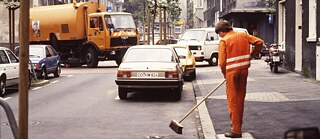At first glance, Germans separate their waste like world champions. But what is behind the “Recycling World Champion Germany”? How do you separate waste properly? And how can sorting waste help the environment? On what we create every day: waste.
Glass containers, Organic waste bin, Yellow bag, Residual waste bin, Paper bin. The German waste management system may seem more complicated than a visit to the authority. And yet, waste sorting is part of everyday life in Germany and one of the most important environmental issues for Germans.Compared to 36 other countries surveyed, Germany has the highest waste separation rate per capita. This is no coincidence: when it comes to protecting the environment, Germans place a high priority on reducing plastic waste in nature and promoting recycling.
But what is the story behind the recycling phenomenon Germany? Let's take a look behind the scenes.
Is Germany the world recycling champion?
Things look good on paper: One in two Germans say they regularly sort their waste. 302 kg of waste per capita is sorted each year. So do Germans recycle like world champions? Not really. Although a lot of waste is sent to recycling facilities, only a small proportion is actually recycled. In the case of plastic and aluminum waste only 35% of the separated waste was recycled in 2020. The majority ended up in incineration plants.The reason for this is that the waste is often too dirty or not separated properly. This can be illustrated with the example of a yogurt cup: A yogurt cup needs to be spooned out, but not perfectly rinsed, in order to be recycled. However, the aluminum lid needs to be separated from the cup so that both materials - aluminum and plastic - can be recycled separately.
So, what goes in which bin?
There are roughly five categories of waste that occur in everyday life: (1) plastic and aluminum packaging, (2) glass, (3) paper, (4) residual waste, and (5) organic waste.A general rule for sorting waste is that the materials should not be too dirty. A pizza box with a few grease stains can go in the paper bin, but a used tissue cannot. In the case of plastic and aluminum packaging, it is important to note that we are talking about packaging, not plastic in general. A used toothbrush or a broken bowl usually belongs in the residual waste bin. However, in some places there are recycling bins where toothbrushes and bowls are collected along with packaging. So it is still a bit complicated.
Does separating waste also protect the climate?
Waste separation is good for the environment. Resources are reused and scarce natural resources are not depleted. However, for 80% of Germans, better waste separation is also an important contribution to climate protection. But how does waste separation protect the climate?To stop climate change, greenhouse gases must be avoided. For example, it takes much more energy to produce new plastic than it does to recycle old plastic. Burning waste in incinerators releases the greenhouse gas CO2. And when our waste rots in landfills, it produces the greenhouse gas methane - a very aggressive gas. Therefore, recycling saves greenhouse gases - in manufacturing, in incinerators and in landfills.
Sorting waste is important, but what really helps the environment is avoiding waste as much as possible. Germans produce 632 kg of waste per capita per year, which is well above the EU average. Some of this waste is shipped to recycling facilities in other countries, where it is processed, incinerated or dumped.
Waste that is not produced does not need to be incinerated and cannot end up in the ocean. Not only consumers, but also companies and politicians have a role to play. After all, there is still packaging that cannot be recycled. And does an organic cucumber really need to be wrapped in plastic?
September 2024




